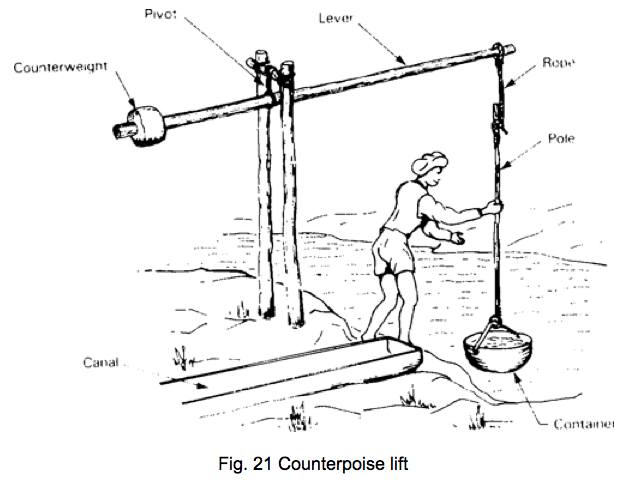Difference between revisions of "Counterpoise lift"
From Akvopedia
(Created page with "A counterpoise lift. Drawing: Also known as ''dhenkli'' or ''picottach'', the counterpoise lift is generally used for lifting of...") |
|||
| Line 1: | Line 1: | ||
| − | [[Image:counterpoiseLift.jpg|thumb|right|300px|A counterpoise lift. Drawing: ]] | + | [[Image:counterpoiseLift.jpg|thumb|right|300px|A counterpoise lift. Drawing: FAO.]] |
Also known as ''dhenkli'' or ''picottach'', the counterpoise lift is generally used for lifting of water from unlined wells, stream or pond for irrigating small fields. It consists of a lever rod supported at a suitable point on a vertical post about which it can swing in vertical direction. About 2000 1itres of water can be lifted from the depth of 2 to 3 metres in one hour. | Also known as ''dhenkli'' or ''picottach'', the counterpoise lift is generally used for lifting of water from unlined wells, stream or pond for irrigating small fields. It consists of a lever rod supported at a suitable point on a vertical post about which it can swing in vertical direction. About 2000 1itres of water can be lifted from the depth of 2 to 3 metres in one hour. | ||
Revision as of 03:59, 2 May 2012
Also known as dhenkli or picottach, the counterpoise lift is generally used for lifting of water from unlined wells, stream or pond for irrigating small fields. It consists of a lever rod supported at a suitable point on a vertical post about which it can swing in vertical direction. About 2000 1itres of water can be lifted from the depth of 2 to 3 metres in one hour.
Contents
Suitable conditions
Construction, operations and maintenance
Costs
Field experiences
Reference manuals, videos, and links
Acknowledgements
- Water lifting devices. Agricoop.nic.in

